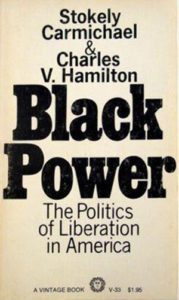June 16 marked the fiftieth anniversary of Stokely Carmichael’s use of the phrase “Black Power” at a rally in Meredith, Mississippi. This was an important moment in the history of post-World War II American intellectual history—something that we are still dealing with today. There have been several intriguing essays about Black Power posted on the web this week, and I hope you check a few of these links out.
Peniel Joseph, one of the key figures in what has been called “Black Power Studies,” has written an essay about Black Power. If you have read some of Joseph’s books on Black Power, you’re familiar with much of his argument here. Nonetheless, it is still worth a read due to Joseph’s tying together of Black Power with today’s Black Lives Matter movement. There is still room within the burgeoning field of Black Power studies to consider the legacy of Black Power as well. I am thinking of something akin to Clarence Lang’s Black Power in the Shadow of the Sixties, which explores the memory of the Civil Rights Movement within the context of American history since the 1980s.
Nathan Connolly’s review essay at Public Books is also a much-needed essay on the Black Power era. Using the books Captive Nation by Dan Berger, It’s Been Beautiful by Gayle Wald, Stokely: A Life by Peniel Joseph, and Black Silent Majority by Michael Javen Fortner, Connolly examines both the history of Black Power and the ways in which that history has been researched. Calling for a “Black Power method” in archival research, Connolly forcefully argues for thinking deeply about how one researches to get at the heart of subjects such as Black Power. “Drawing black thought from the archive remains critical to countering dominant white narratives,” wrote Connolly, “and thus critical to a Black Power method.”[1] This is a lesson important for all of us, because the continuing growth and strengthening of intellectual history as a field will mean pushing deeper for sources to further explain the past.
Meanwhile, this piece over at Print magazine’s website should be of interest to anyone who is fascinated by the history of the book in the twentieth century. Josh MacPhee goes into detail behind the designing of the now-iconic cover to the book Black Power, written by  Charles V. Hamilton and Stokely Carmichael. In addition, MacPhee provides a history of the designs of covers of books on African American history, politics, and culture in the mid-20th century. I’m not sure what’s the most fascinating part of this article—its coverage of the evolution of a variety of American books on the Black experience, or the descriptions of book covers of Black Power from across the world.
Charles V. Hamilton and Stokely Carmichael. In addition, MacPhee provides a history of the designs of covers of books on African American history, politics, and culture in the mid-20th century. I’m not sure what’s the most fascinating part of this article—its coverage of the evolution of a variety of American books on the Black experience, or the descriptions of book covers of Black Power from across the world.
I also wish to recommend some documentaries. Black Power Mixtape and Black Panthers: Vanguard of the Revolution are, of course, the go to entries for this subject. But I would also recommend taking a look at the final chapters of the well-regarded Eyes on the Prize miniseries. The final seven parts of the miniseries cover the rise and fall of Black Power, and also the rise of “Law and Order” politics as well as the growing strength of Black political power in the 1970s and 1980s. I would recommend watching those to get a greater grasp of the period, and the myriad of intellectual and political options African Americans debated over in the 1960s and beyond.
At this point, I wish to take a moment to remember the Charleston 9. This time last year, the entire nation was stunned by the events in Charleston, South Carolina on June 17, 2015. Living in South Carolina, I can tell you that the citizens of this state continue to wrestle with this event and the toxic mix of history and white supremacy here in South Carolina (but, by no means, bound within the state’s borders) that contributed to the attack. I hope for a day when we can finally think of terrorist attacks and mass shootings as something in the past.
[1] Nathan Connolly, “A Black Power Method,” http://www.publicbooks.org/nonfiction/a-black-power-method.

0